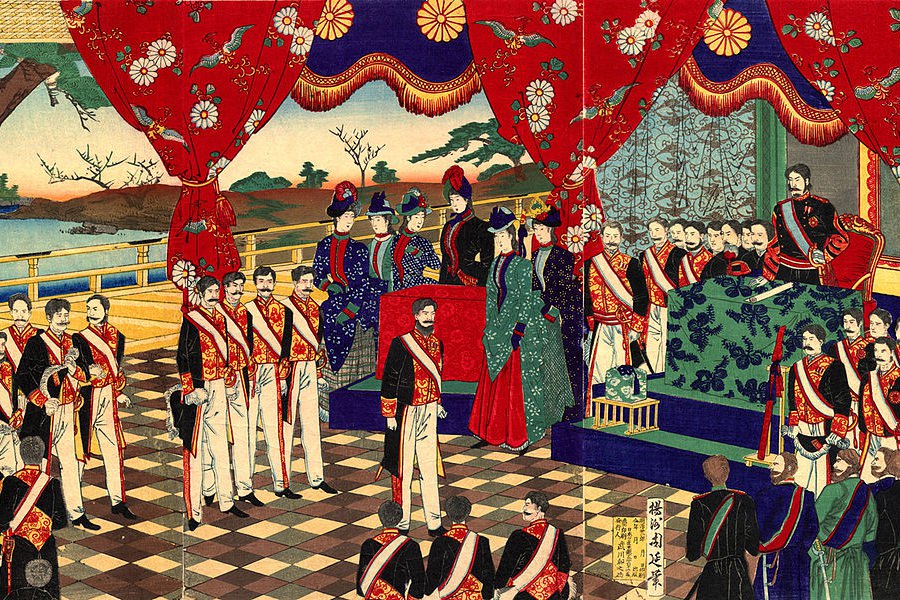Japan’s industrialization in the late 19th and early 20th centuries is a fascinating and remarkable story of a nation that transformed itself from an isolated feudal society into a modern industrial powerhouse. The history of Japan’s industrialization is filled with challenges, determination, and the foresight of visionaries who played a vital role in various development steps. This story delves into the key moments and players that shaped Japan’s industrial revolution, and examines how their contributions helped propel the nation onto the world stage.
The Meiji Restoration (1868-1912)
The Meiji Restoration was a turning point in Japan’s history that marked the beginning of its industrialization journey. In 1868, the Tokugawa shogunate was overthrown, and the imperial rule was restored under Emperor Meiji. Determined to catch up with Western powers, Japan’s leaders embarked on a program of rapid modernization and industrialization.
Sakichi Toyoda (1867-1930)
One of the notable figures during this period was Sakichi Toyoda, a talented inventor and entrepreneur who is often referred to as the father of Japan’s industrial revolution. He revolutionized the textile industry by inventing the automatic power loom, which greatly increased the efficiency of textile production. This innovation not only transformed Japan’s textile industry but also laid the groundwork for the Toyota Motor Corporation, one of the world’s leading automotive manufacturers.
Eiichi Shibusawa (1840-1931)
Another significant figure in Japan’s industrialization was Eiichi Shibusawa, a prominent businessman and industrialist. He founded the First National Bank of Japan and played a crucial role in the development of the country’s modern financial system. Shibusawa also helped establish over 500 companies in various industries, including textiles, railroads, and steel, contributing immensely to Japan’s economic growth.
Yataro Iwasaki (1835-1885)
Yataro Iwasaki, the founder of Mitsubishi, was another key player in Japan’s industrialization. His vision for a diversified business led to the establishment of the Mitsubishi Zaibatsu, which played a significant role in the development of Japan’s shipping, mining, and heavy industries. The Mitsubishi conglomerate would later evolve into one of the most influential corporations in Japan and the world.
The Taisho Democracy (1912-1926)
The Taisho period saw the continuation of Japan’s industrialization efforts and the growth of democracy. It was during this era that Japan emerged as a major industrial and military power.
Korekiyo Takahashi (1854-1936)
Korekiyo Takahashi, a prominent Japanese statesman and financier, served as the governor of the Bank of Japan and later as Prime Minister. He implemented various economic policies that promoted industrialization, including the gold standard, which stabilized Japan’s currency and stimulated economic growth. Takahashi’s prudent fiscal policies helped Japan navigate the economic challenges of the post-World War I era.
Inazo Nitobe (1862-1933)
Inazo Nitobe, a prolific writer and educator, contributed to Japan’s industrialization by promoting international understanding and cooperation. As an influential figure in the League of Nations, Nitobe sought to strengthen Japan’s ties with other nations, fostering a global environment that facilitated economic growth and industrialization.
The Showa Era (1926-1989)
The Showa era, which began with the reign of Emperor Hirohito, was marked by both remarkable economic growth and the devastation of World War II. Despite the challenges, Japan’s industrialization continued to progress, thanks to the resilience and determination of its people and the ingenuity of its leaders.
Kiichiro Toyoda (1894-1952)
Kiichiro Toyoda, the son of Sakichi Toyoda, was instrumental in transitioning the family’s business from textiles to automobiles. In 1937, he founded the Toyota Motor Corporation, which would go on to become a global leader in the automotive industry. Kiichiro’s vision and innovation helped to establish Japan as a major player in the global automobile market.
Soichiro Honda (1906-1991)
Soichiro Honda, the founder of Honda Motor Co., was another pivotal figure in Japan’s industrial development during the Showa era. He started his company in 1948, initially focusing on motorized bicycles. Honda later expanded into motorcycles and automobiles, with innovative designs and cutting-edge technology that garnered international acclaim. Honda’s success contributed significantly to Japan’s reputation as a world leader in automotive manufacturing.
Post-War Recovery and the Japanese Economic Miracle
The devastation of World War II left Japan’s industries in ruins, but the nation’s resilience and determination to rebuild led to an unprecedented economic boom, often referred to as the Japanese Economic Miracle.
Shigeru Yoshida (1878-1967)
Shigeru Yoshida, a prominent Japanese diplomat and politician, played a key role in shaping Japan’s post-war economic policy. As Prime Minister, he pursued a strategy of close cooperation with the United States and focused on rebuilding Japan’s economy through industrial expansion. Yoshida’s policies laid the foundation for Japan’s rapid economic growth in the decades that followed.
Hayato Ikeda (1899-1965)
Hayato Ikeda, another influential Japanese Prime Minister, implemented the Income Doubling Plan in 1960, aiming to double Japan’s national income within ten years. His policies encouraged investment in infrastructure, education, and research, which fueled rapid industrial growth and propelled Japan into the ranks of the world’s leading economies.
Akio Morita (1921-1999) and Masaru Ibuka (1908-1997)
The founders of Sony Corporation, Akio Morita and Masaru Ibuka, played a significant role in Japan’s post-war industrial success. They established the company in 1946 and went on to produce groundbreaking consumer electronics, such as the first transistor radio and the Walkman portable music player. Their innovations not only revolutionized the global electronics market but also helped solidify Japan’s reputation as a technological powerhouse.
Japan’s Industrialization
The history of industrialization in Japan is a remarkable tale of a nation that rose from isolation and feudalism to become a global economic and industrial powerhouse. The determination, vision, and innovation of notable individuals such as Sakichi Toyoda, Eiichi Shibusawa, Yataro Iwasaki, Kiichiro Toyoda, Soichiro Honda, Shigeru Yoshida, Hayato Ikeda, Akio Morita, and Masaru Ibuka contributed significantly to Japan’s rapid industrial development.
Their legacies continue to shape the nation’s industries and economy, as well as inspire future generations of entrepreneurs, inventors, and leaders. The story of Japan’s industrialization serves as a testament to the power of human ingenuity, resilience, and the ability to overcome adversity to achieve greatness.
